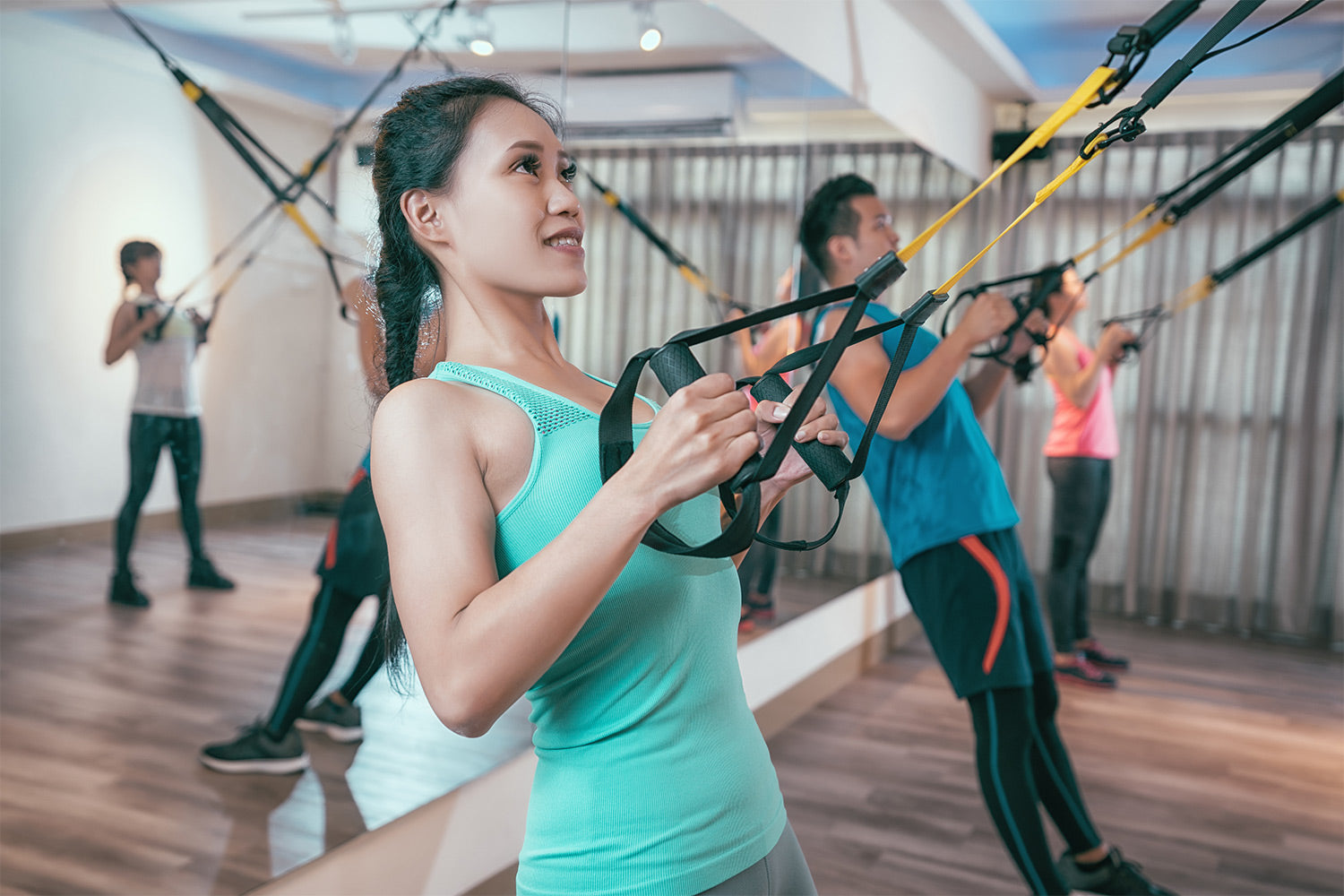When it comes to building your workout routine, it’s important to work out your muscles at least once per week while giving them ample time for recovery. The best way to achieve this is with the push-pull split, which works out your “push” and your “pull” muscles on different days.
Beginners can do push-pull routines in the gym, and even intermediate or advanced leveled gym-goers can too.
If you’re wondering what each type of workout includes, then read on for a thorough explanation of the push-pull split and the main difference between them.
What Is a Push Workout?
A push workout is one in which you use your body’s “push” muscles—the ones that push weight away from the body. This includes the following:
- Chest: Your chest is made up of many muscles, but the one we’re most concerned with is the pectoralis major—which is made up of two fan-shaped muscles that stretch from your armpit to your collarbone. The pectoralis major includes an upper, middle, and lower part, each of which must be worked out for a well-developed chest.
- Shoulders: It may seem like the shoulders are just one muscle, but they are actually made out of three different “heads”—front, middle, and rear. In a well-developed workout routine, you will include shoulder exercises that target each of these for well-rounded shoulders.
- Triceps: Your tricep muscles cover the entire back of your upper arm and are the most important factor in determining your arm size. They’re also made up of three “heads”—medial, lateral, and long, which must be worked out for well-defined triceps.
Working out these muscles can make you look and feel amazing; the push workout is also important for improving your daily functionality. For instance, pressing yourself off the floor or carrying something heavy activates these muscles. The stronger they are, the easier these daily activities will be.
Other push movements examples include lateral raises, shoulder press, and barbell rows.
Here are two routines to get you started.
Sample At-Home Push Routine
While working with weights never hurts, it’s completely possible to build up your upper body with no equipment. Here are some classic exercises for an upper-body push day that will leave you with a well-developed chest, shoulders, and triceps.
- Regular Push-Ups: This is a classic exercise that targets all of your push muscles and, as a bonus, your abs. To do the perfect pushup, make sure to keep your back straight the entire time and to try to make your chest lightly touch the floor.
- Diamond Push-Ups: While there are countless variations on the pushup, this is perhaps the most popular since it targets the long head of your tricep muscles. Keep your hands in a diamond shape by connecting your index fingers and thumbs. Next, push your chest down towards your hands while thinking about using your tricep muscles.
- Tricep dips: This is another excellent way to work out your entire tricep muscles without equipment—lean backward on a chair with your hands facing forward. Then simply dip down using your triceps muscles while keeping the rest of your body relaxed.
- Pike Push-Ups: This is a great way to target the upper head of the shoulders. Get into a downward-facing dog position and drive your head towards the ground using your shoulders.
Sample Push Exercises With Weights
Although bodyweight workouts are just as effective in building muscle, they usually require more reps (which means more time spent working out). If you want to minimize how many repetitions of an exercise you do, then these exercises will supercharge your muscle growth on push days:
- Military Press: This exercise involves using a barbell that you press overhead. It’s a superior workout because it simultaneously works out your upper chest, your entire triceps, and the front and middle parts of your shoulders. Plus, it’s not assisted by a machine, which can challenge your mind.
- Decline Bench Press: This simple exercise requires you to press up dumbbells or a barbell on a flat bench. This exercise is superior for building the lower chest, which is key for maximizing your chest size.
- Triceps Press-Down: Using a cable machine, this exercise isolates your triceps, which allows you to build as much of it as you want without growing other muscle groups.
- Dumbbell Lateral Raise: Many push workouts engage the front head of the shoulders, which causes people to overdevelop this part of the shoulders. To balance out your muscle development, it’s important to do exercises that isolate the rear head, which this exercise is perfect for.
What Is a Pull Workout?
A pull workout engages your body’s “pull” muscles responsible for contracting weight towards the body. This includes the following:
- Back: Your back is actually made up of three muscles. The latissimus dorsi (AKA “lats”) make up the largest portion of your back, covering the entire middle and bottom. Then you have the trapezius (AKA “traps”), a diamond-shaped muscle that starts at the base of your neck and extends to the middle of your back. Last, you have your rhomboid muscles located underneath the traps and play a major role in your posture.
- Biceps: This part of your body requires no explanation. Made up of a long head and a short head, it’s the part of the arm that gets used most often throughout the day and is something we all want to build up.
- Rear Deltoids: Finally, the rear deltoids are muscles located on the back of your shoulders. These muscles pull your shoulders back, which is why they’re so important for posture. Aside from that, they make your shoulders look well-developed from all sides.
Sample At-Home Pull Exercises
While it’s a bit harder to work out the back and the biceps without any equipment, it can certainly be done. While we recommend investing in the proper equipment for your pull workout (such as a rowing machine), here are some exercises you can follow at home on pull days:
- Cat-Cow Position: This yoga pose alternates between curving your back and looking upwards and curving your back down while looking towards your navel. While it won’t give you serious gains, it’s not a bad way to strengthen your lats while giving you a nice stretch.
- Back Crunches: If done enough times, this bodyweight workout can leave you seriously sore (which is exactly what we want when it comes to building muscle). To do it, lie down on the floor and use your back muscles to “crunch” your back.
- No-Equipment Rows: Although a rowing machine is seriously beneficial when doing these, you can try it out without any equipment. Simply stand with your legs straight and your back extended backward. Then pull your arms back until you feel a slight pinch in your lats.
Sample Pull Routine With Weights
Some pull movements you could try include:
- Rows: This can be done with a rowing machine (which is also an awesome cardio workout), cables at the gym, or a pair of dumbbells. The point is to use weight to contract your back muscles inwards using enough weight where it feels challenging.
- Lat Pulldowns: This workout requires a lat pulldown machine and is the ideal way to target your lats—which is slightly hard to do with other gym equipment.
- Rear Delt Flies: Many traditional back workouts don’t target the rear delts. For this reason, it’s important to do isolation exercises to work them out, such as the rear delt flyes with dumbbells.
- Bicep Curls: Hey, we all want nice arms! Unfortunately, many pull workouts don’t contribute to growing your bicep muscles, which is why it’s important to train them in isolation. Fortunately, there are tons of bicep workouts that you can do. The bicep curl is the easiest and can even be done with anything heavy—such as a gallon of milk.
- Other examples of upper body pull workouts include overhead presses, barbell curl, hammer curl, and pull-ups.
The Benefits of a Push-Pull Workout Split
In sum, a push workout is one that targets your chest, shoulders, and triceps, while a pull workout targets the back and biceps. The benefit of a push-pull routine is that it allows you to rest one set of muscles, which aids in recovery and muscle growth.
We recommend doing at least one push and one pull workout per week. But for maximum muscle growth, it’s not a bad idea to work out at least twice per week.
Sources:
Downward-Facing Dog: How to Practice Adho Mukha Svanasana | Yoga Journal




Leave a comment
All comments are moderated before being published.
This site is protected by hCaptcha and the hCaptcha Privacy Policy and Terms of Service apply.